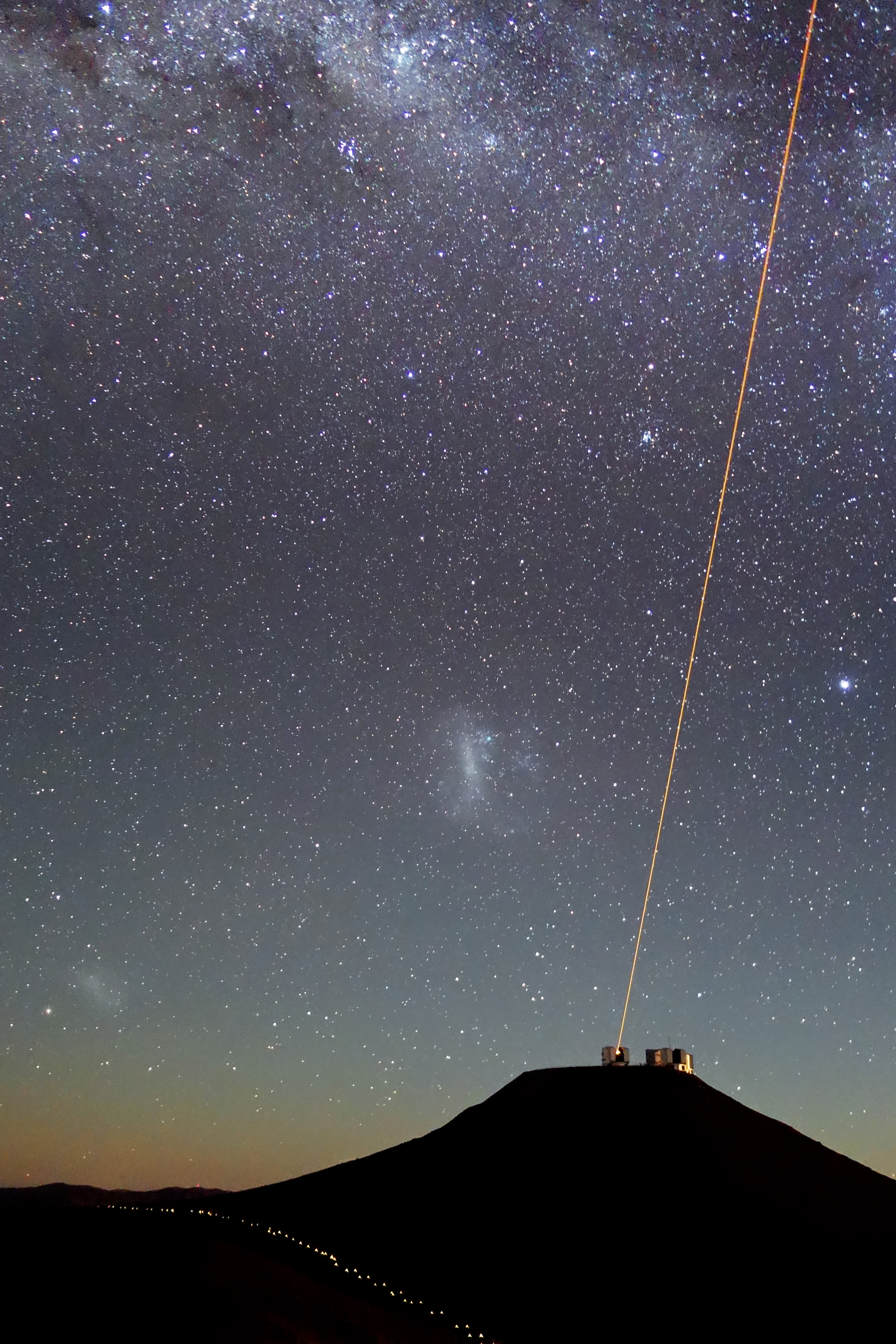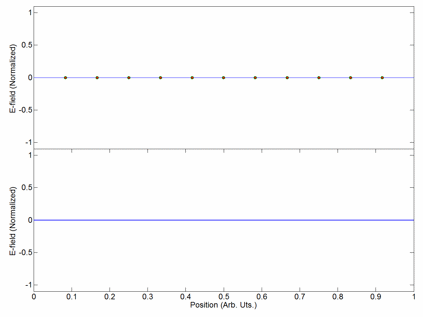|
Regenerative Amplification
In laser science, regenerative amplification is a process used to generate short but strong pulses of laser light. It is based on a pulse trapped in a laser resonator, which stays in there until it extracts all of the energy stored in the amplification medium. Pulse trapping and dumping is done using a polarizer and a Pockels cell, which acts like a quarter wave-plate. Operating principle When a pulse with vertical polarization is reflected off the polarizer, after a double pass through the Pockels cell it will become horizontally polarized and will be transmitted by the polarizer. After a double pass through the amplification medium, having the same horizontal polarization, the pulse will be transmitted by the polarizer. If a voltage is applied to the Pockels cell, a double pass through it will change the polarization of the pulse to vertical, so the pulse will be reflected off the polarizer and will exit the cavity. If no voltage is applied, then a double pass through the Pocke ... [...More Info...] [...Related Items...] OR: [Wikipedia] [Google] [Baidu] |
Laser Science
Laser science or laser physics is a branch of optics that describes the theory and practice of lasers. Laser science is principally concerned with quantum electronics, laser construction, optical cavity design, the physics of producing a population inversion in laser media, and the temporal evolution of the light field in the laser. It is also concerned with the physics of laser beam propagation, particularly the physics of Gaussian beams, with laser applications, and with associated fields such as nonlinear optics and quantum optics. History Laser science predates the invention of the laser itself. Albert Einstein created the foundations for the laser and maser in 1917, via a paper in which he re-derived Max Planck’s law of radiation using a formalism based on probability coefficients ( Einstein coefficients) for the absorption, spontaneous emission, and stimulated emission of electromagnetic radiation. The existence of stimulated emission was confirmed in 1928 by Rudol ... [...More Info...] [...Related Items...] OR: [Wikipedia] [Google] [Baidu] |
Laser
A laser is a device that emits light through a process of optical amplification based on the stimulated emission of electromagnetic radiation. The word "laser" is an acronym for "light amplification by stimulated emission of radiation". The first laser was built in 1960 by Theodore H. Maiman at Hughes Research Laboratories, based on theoretical work by Charles Hard Townes and Arthur Leonard Schawlow. A laser differs from other sources of light in that it emits light which is ''coherent''. Spatial coherence allows a laser to be focused to a tight spot, enabling applications such as laser cutting and lithography. Spatial coherence also allows a laser beam to stay narrow over great distances (collimation), enabling applications such as laser pointers and lidar (light detection and ranging). Lasers can also have high temporal coherence, which allows them to emit light with a very narrow spectrum. Alternatively, temporal coherence can be used to produce ultrashort pulses of ligh ... [...More Info...] [...Related Items...] OR: [Wikipedia] [Google] [Baidu] |
Pockels Cell
The Pockels effect or Pockels electro-optic effect, named after Friedrich Carl Alwin Pockels (who studied the effect in 1893), changes or produces birefringence in an optical medium induced by an electric field. In the Pockels effect, also known as the linear electro-optic effect, the birefringence is proportional to the electric field. In the Kerr effect, the refractive index change (birefringence) is proportional to the square of the field. The Pockels effect occurs only in crystals that lack inversion symmetry, such as KH2PO4 (KDP), KD2PO4 (KD*P or DKDP), lithium niobate (LiNbO3), and in other non-centrosymmetric media such as electric-field poled polymers or glasses. The electro-optic properties of materials like KDP and its isomorphs that exhibits that Pockels effect has been extensively studied over the years to allow accurate models for simulations. Pockels cells Pockels cells are voltage-controlled wave plates. The Pockels effect is the basis of the operation of Pockels ... [...More Info...] [...Related Items...] OR: [Wikipedia] [Google] [Baidu] |
Quarter-wave Plate
A waveplate or retarder is an optical device that alters the polarization state of a light wave travelling through it. Two common types of waveplates are the ''half-wave plate'', which shifts the polarization direction of linearly polarized light, and the ''quarter-wave plate'', which converts linearly polarized light into circularly polarized light and vice versa. A quarter-wave plate can be used to produce elliptical polarization as well. Waveplates are constructed out of a birefringent material (such as quartz or mica, or even plastic), for which the index of refraction is different for light linearly polarized along one or the other of two certain perpendicular crystal axes. The behavior of a waveplate (that is, whether it is a half-wave plate, a quarter-wave plate, etc.) depends on the thickness of the crystal, the wavelength of light, and the variation of the index of refraction. By appropriate choice of the relationship between these parameters, it is possible to introduce ... [...More Info...] [...Related Items...] OR: [Wikipedia] [Google] [Baidu] |
Chirped Pulse Amplification
Chirped pulse amplification (CPA) is a technique for amplifying an ultrashort laser pulse up to the petawatt level, with the laser pulse being stretched out temporally and spectrally, then amplified, and then compressed again. The stretching and compression uses devices that ensure that the different color components of the pulse travel different distances. CPA for lasers was introduced by Donna Strickland and Gérard Mourou at the University of Rochester in the mid-1980s, work for which they received the Nobel Prize in Physics in 2018. CPA is the current state-of-the-art technique used by most of the highest-power lasers in the world. Background Before the introduction of CPA in the mid-1980s, the peak power of laser pulses was limited because a laser pulse at intensities of gigawatts per square centimeter causes serious damage to the gain medium through nonlinear processes such as self-focusing. For example, some of the most powerful compressed CPA laser beams, even in an ... [...More Info...] [...Related Items...] OR: [Wikipedia] [Google] [Baidu] |
Raman Amplification
Raman amplification . ''''. is based on the stimulated (SRS) phenomenon, when a lower frequency 'signal' induces the of a higher-frequency 'pump' photon in an optical medium in the nonlinear regime. As a result of this, another 'sign ... [...More Info...] [...Related Items...] OR: [Wikipedia] [Google] [Baidu] |
Optical Amplifier
An optical amplifier is a device that amplifies an optical signal directly, without the need to first convert it to an electrical signal. An optical amplifier may be thought of as a laser without an optical cavity, or one in which feedback from the cavity is suppressed. Optical amplifiers are important in optical communication and laser physics. They are used as optical repeaters in the long distance fiberoptic cables which carry much of the world's telecommunication links. There are several different physical mechanisms that can be used to amplify a light signal, which correspond to the major types of optical amplifiers. In doped fiber amplifiers and bulk lasers, stimulated emission in the amplifier's gain medium causes amplification of incoming light. In semiconductor optical amplifiers (SOAs), electron-hole recombination occurs. In Raman amplifiers, Raman scattering of incoming light with phonons in the lattice of the gain medium produces photons coherent with the inco ... [...More Info...] [...Related Items...] OR: [Wikipedia] [Google] [Baidu] |
Gain-switching
Gain-switching is a technique in optics by which a laser can be made to produce pulses of light of extremely short duration, of the order of picoseconds ( 10−12 s). In a semiconductor laser, the optical pulses are generated by injecting many carriers (electrons) into the active region of the device, bringing the carrier density within that region from below to above the lasing threshold. When the carrier density exceeds that value, the ensuing stimulated emission results in the generation of many photons. However, carriers are depleted as a result of stimulated emission faster than they are injected. So the carrier density eventually falls back to below lasing threshold which results in the termination of the optical output. If carrier injection has not ceased during this period, then the carrier density in the active region can increase once more and the process will repeat itself. The figure on the right shows a typical pulse generated by gain-switching with a sinus ... [...More Info...] [...Related Items...] OR: [Wikipedia] [Google] [Baidu] |
Modelocking
Mode locking is a technique in optics by which a laser can be made to produce pulses of light of extremely short duration, on the order of picoseconds (10−12 s) or femtoseconds (10−15 s). A laser operated in this way is sometimes referred to as a femtosecond laser, for example, in modern refractive surgery. The basis of the technique is to induce a fixed phase relationship between the longitudinal modes of the laser's resonant cavity. Constructive interference between these modes can cause the laser light to be produced as a train of pulses. The laser is then said to be "phase-locked" or "mode-locked". Laser cavity modes Although laser light is perhaps the purest form of light, it is not of a single, pure frequency or wavelength. All lasers produce light over some natural bandwidth or range of frequencies. A laser's bandwidth of operation is determined primarily by the gain medium from which the laser is constructed, and the range of frequencies over which a lase ... [...More Info...] [...Related Items...] OR: [Wikipedia] [Google] [Baidu] |
Q-switching
Q-switching, sometimes known as giant pulse formation or Q-spoiling, is a technique by which a laser can be made to produce a pulsed output beam. The technique allows the production of light pulses with extremely high (gigawatt) peak power, much higher than would be produced by the same laser if it were operating in a continuous wave (constant output) mode. Compared to modelocking, another technique for pulse generation with lasers, Q-switching leads to much lower pulse repetition rates, much higher pulse energies, and much longer pulse durations. The two techniques are sometimes applied together. Q-switching was first proposed in 1958 by Gordon Gould, p. 93. and independently discovered and demonstrated in 1961 or 1962 by R.W. Hellwarth and F.J. McClung at Hughes Research Laboratories using electrically switched Kerr cell shutters in a ruby laser. Optical nonlinearities such as Q-switching were fully explained by Nicolaas Bloembergen, who won the Nobel prize in 1981 for this work. ... [...More Info...] [...Related Items...] OR: [Wikipedia] [Google] [Baidu] |





.jpg)